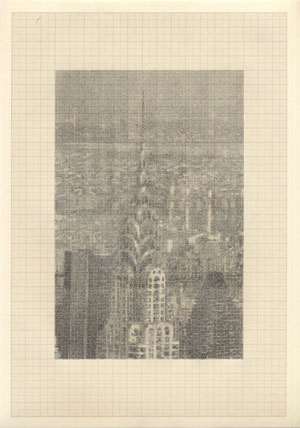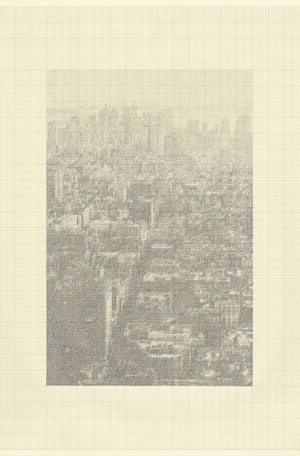Lora Reynolds is currently showing Ewan Gibbs’ drawings, From the Empire State Building, a series in which Gibbs uses scenes of the city as a means of exploring the mechanics of perception.

Ewan Gibbs ... From the Empire State Building... 2004... 11 5/8 x 8 1/4 inches... Pencil on graph paper
The different panoramas that come together in Gibbs’ work might represent a city in general terms (a dense wall of tall buildings or a traffic-filled street), or they might depict recognizable elements of the New York skyline. The series presents an image of the city that is at once general and specific, but it’s not the city itself that is the focus of the work.
Gibbs insists that the exact location represented in From the Empire State Building is totally devoid of any particular meaning and that it carries no special weight within the images. “It could be anywhere. It happens to be New York.” [1.] And yet cities are inherently full of layers of associations that are difficult to ignore. A location like New York has a strong symbolic charge, and Gibbs noted that an earlier project he had designed for that city had to be put on hold after September 11th 2001, when the city was suddenly consumed by a single narrative (though it seems to me that that one narrative has within it a million unique trajectories). To avoid getting sidetracked by that kind of predetermined meaning, the views Gibbs selects can be as arbitrary as a car-filled street, seen from above, with no identifying landmarks and no particular framing. At other times, Gibbs seizes on more iconic structures, like the Chrysler Building, but he transforms these postcard-friendly subjects into slightly disoriented scenes with fuzzy contours. In some ways they seem almost like drawings made from memory, as if they were records of remembered places in which the details are a little hard to grasp.

Ewan Gibbs ... From the Empire State Building... 2004... 11 5/8 x 8 1/4 inches... Pencil on graph paper
In fact each of Gibbs’ drawings has nothing to do with the vagaries of memory. Instead they’re rendered in a painstakingly exacting process in which a photograph taken by the artist is photocopied and transformed into a black and white image. He then overlays a grid onto the photocopy and begins transferring the image one square at a time to a sheet of graph paper. Gibbs builds up his urban landscapes bit by bit, filling the graph paper with tiny dashes or circles which he matches to the varying tonal values of the original photocopy. The city materializes out of these discrete marks, and the drawings are extremely appealing for their sheer delicacy and the artist’s careful hand. The finished pictures appear to be smooth, flawless wholes from a distance, but at close range they dissolve into pixilated abstractions.
Technically it’s a fairly rigid process that produces these images. There is nothing spontaneous in the copying of dark spaces and light spaces from the Xerox to the paper. But this repetitive practice is a necessary part of Gibbs’ overall objective. In using individual marks, he wants to emphasize the fragmentary nature of images, especially photographic images, and the active role that our eyes play in completing a picture.[2.] When you look at one of Gibbs’ compositions from the proper distance, your eye ignores the blank space around each separate stroke, blurring those spaces so that the gaps are indistinguishable and the picture reads as having a consistent surface. In other words, your eyes cheat so that what you see is not what is actually on the paper.
And yet somehow the repetitive quality of the project leads me to a bit of a dead end. Where do I go once I’ve recognized the shift between part and whole that is constantly taking place somewhere between the dashes on the surface of the paper and my optic nerve? If a narrative, or even simply subject matter, is really inconsequential to these drawings, they become empty rather quickly. I think that what might sustain them is the combination of the recognizable (the Chrysler Building) and the generic (a congested street) within the selection of works in this show. In looking over time we’re not just recognizing the mechanics of viewing, we’re also looking for something. We might be pulling together a narrative that the artist didn’t intend and which is not technically there. But the whole point of Gibbs’ mosaic-like marks on the paper is that, without an eye to do the work, the image isn’t really there, either.
1. In conversation with Annette DiMeo Carlozzi at Lora Reynolds Gallery, Austin, 7. May, 2005.
[return to the article]
Images courtesy Lora Reynolds Gallery.
Heather Mathews is an art historian living in Austin.



